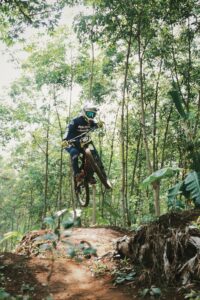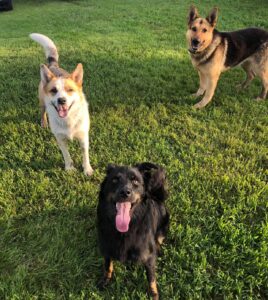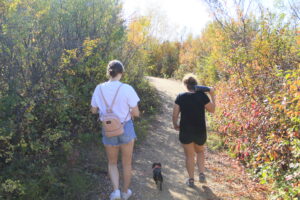What do dog-poop bags and fat-tire bikes have in common?
The long answer is much more complicated than one might expect and not immediately obvious. The short answer is: both are seemingly innocent and both harm the environment.
Fat Tires, Far from Good Results

First, let’s talk about fat-tire bikes. I own one myself and it’s great. I get a better workout than I would from my regular bike and it’s got good traction in winter. So what’s the downside? Although with good intent, riders tend to carve out new trails wherever they go, flattening the vegetation, which puts fragile plants within an already fragmented ecosystem at a very high risk.
Meewasin asks that you stick to the trails and be respectful of both nature and other nature lovers. Exploring is good; destroying is not.
Who Gives a Crap?
The second seemingly harmless activity is the dumping of dog poo bags in natural areas throughout Saskatoon and area: on the trails, near the river, on beaches and even up in trees. Yes, in trees! I couldn’t understand why my fellow outdoor enthusiasts would think that this behaviour is okay. Are they horrible, nasty people?
No. Rather, these dog owners are likely well-intentioned people who have been conned by clever marketing and the terms, “biodegradable” and “compostable”.
Whenever something sounds too good to be true, it’s likely not true. There is no such thing as a free ride and someone or something always pays. In this case, it is the environment.
Some Bags Are Sustainable Though… Right?
What do those guilt-reducing terms, biodegradable and compostable, actually mean? Without getting too technical, “biodegradable” means that something will decompose naturally. In truth, everything in the whole world is biodegradable, if you wait long enough. A plastic bag can take up to 500 years to degrade in a landfill. Biodegradable bags, left out in the open, don’t actually break down; rather, they photo-degrade and become micro-plastics that continue to pollute the environment.

“Compostable” means that organic matter will rot. The problem with compostable bags and their contents is that they require industrial or commercial facilities to kill any pathogens. Such facilities are not available in Saskatoon. The City of Saskatoon does not allow compostable bags or their contents in the green bin and recommends putting animal waste in a plastic bag and disposing of it in the garbage (black bin). This begs the question, “what is the point of buying dog-poo bags when they just end up in the garbage where they neither biodegrade nor compost?” In other words, our good intentions are for nought.
Drop it Where It’s Hot? Maybe NOT

Since plastic bags are problematic and dog poo is biodegradable, is it better to just leave it where it drops and forego the bag altogether? Poop will decompose in no time, right? Yes, but dog poop may contain pathogens that can end up in the river or in other dogs’ stomachs (some dogs, like mine, eat other dogs’ poop). And, some of those pathogens, like hookworms, tapeworms roundworms, E.coli, giardia and other diseases can be transmitted to other people and pets in your household. Children and immune-compromised individuals are the most likely to suffer a parasitic infestation. So, it is still better to use a dog-poo bag than to leave the poo lying around outdoors. That, and the fact that no one wants to step in your dog’s doo-doo! Yuck.
So, What are the Good Options?
The more research I did for this article, the more I realized there are no quick fixes to the problem. I discovered that, beyond putting the poop bag in the garbage, other options for disposal include home composting, industrial composting, flushing down the toilet, mouldering, burying, re-using regular plastic garbage bags (rather than poop-specific bags), using special poop pick-up tools, purchasing or building a dog-poo-specific composting bin, and vermicomposting. You can even hire a professional dog-poop removal company who will come to your house and deal with all that poo. Even Saskatoon has several of these services. Is your head spinning yet? With so many options, what is the best thing to do?
Based on my research and City of Saskatoon’s waste management protocols, the best advice I came up with, while not perfect, is this:
- Encourage your dog to do its business in your yard BEFORE you take them to the dog park. Pick up the poo with a small spade or trowel and put it in a container that is exclusive to that use and of a moderate size. When the container is full, dump the contents in the toilet.
- Buy or build a dog-poop-specific composter. Here is where it gets tricky. Unlike regular composting, you will need to commit to pathogen testing and understand temperature requirements. Most of us aren’t master composters so you may want to wait until the City brings in an industrial model. If you still really want to compost dog poo but can’t test for pathogens, go ahead, but don’t put dog compost on the vegetable garden. Instead, use it on shrubs, flowers, and trees.
- If flushing dog poo is too gross for you or you don’t have the space for composting, the next best option is to put the poo collected from your yard in an appropriately sized plastic bag (i.e., don’t use a massive garbage bag to hold a few ounces of poo), preferably one that has already been used several times before for other purposes, and then put it in the garbage (the black bin). The City of Saskatoon requires that dog poo be bagged. This is not an ideal solution; the plastic bag and the poo it contains will take a very long time to decompose in the landfill as oxygen is needed for decomposition and there is no oxygen in the landfill. Some cities, like Vancouver, allow animal waste to go in the green bin because their composting facilities reach temperatures that can kill any pathogens, but Saskatoon does not accept animal waste in its green bins. If you have strong feelings about this, please contact the City and ask them to upgrade their composting facilities.
- If your dog refuses to poop in your yard, you have a couple options. When out in nature, I use the plastic produce bags that are ubiquitous in grocery stores. If I have to use a plastic bag anyway, I figure I may as well give a second life to one that would otherwise go into the landfill. Produce bags are flimsy, which is actually good in this case. If you don’t have any plastic produce bags because you use reusable produce bags, you are my hero! In this case, you may have to buy some. If so, buy the smallest, most environmentally friendly bag you can afford. This is much more difficult than it sounds; there are so many brands on the market, all espousing to be the most environmentally friendly. If possible, look for bags that comply with Canadian BNQ (CAN/BNQ 0017-088) and ASTM 6400 standards.
- Whatever bag you use, do NOT leave it on the trail or up a tree in the expectation that it will take care of itself by simply disappearing (it won’t!). And, let’s be honest with ourselves; we are unlikely to achieve perfection on the dog poop issue, but we can do the next best thing within our local constraints and limitations.
Conclusion
Many nature-lovers are aware and can agree: the spaces that provide us with a sense of adventure, clarity, and peace, are also in need of our help. Meewasin manages areas of natural landscapes and prairie that are endangered, and are saddened to see them additionally damaged because of human actions – even the seemingly harmless ones.
Meewasin and the Earth need our help. By understanding and changing the negative effects of our daily actions, and sharing that knowledge with others, we can all make a difference.
Many well intended, seemingly innocent actions can be harmful; like biking outdoors, while not realizing it’s damaging a sensitive ecosystem, or attempting to ditch all plastic but unintentionally resulting in a spread of dangerous bacteria from your pooch. Now that we know better, let’s advocate these messages to others, and get involved in the stewardship of natural spaces!
Most of this article was written by Patricia Albers, M. Ed.
Patricia is a recently retired professional who delights in all things natural. She has been involved in various environmental organizations for most of her adult life and is especially committed to preserving natural grasslands. She is a supporter of and volunteer with the Meewasin Valley Authority. As an artist, she finds both solace and inspiration in nature.
Resources
https://www.saskwastereduction.ca/blog/green-living/2015/08/26/the-doos-and-don’ts/
https://davidsuzuki.org/queen-of-green/disposing-dog-poop-green-way/
https://ourpetshealth.com/info/how-to-dispose-of-dog-poop
The Pet Poo Pocket Guide: How to Safely Compost and Recycle Pet Waste by Rose Seeman. Publisher: New Society Publishers (May 1 2015)




